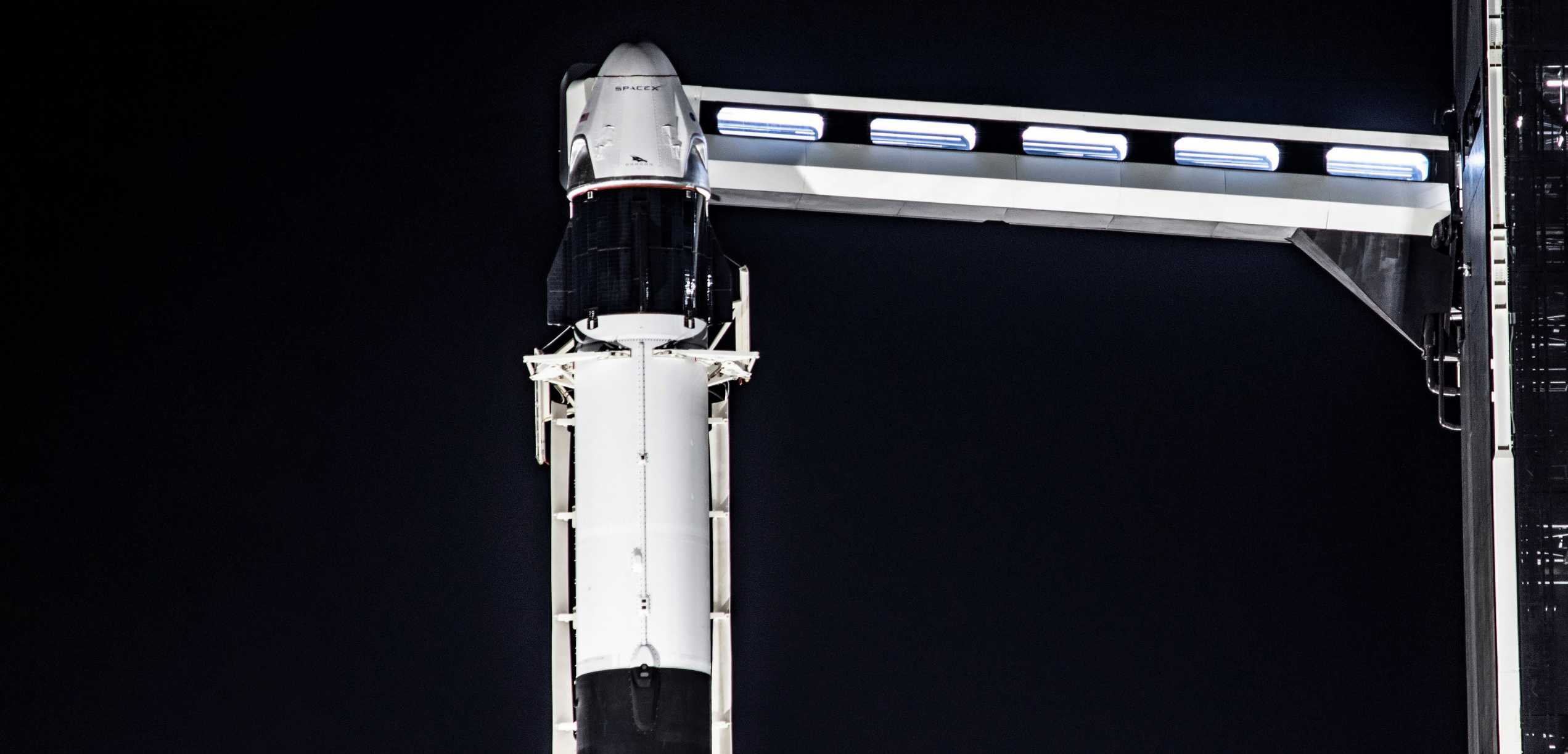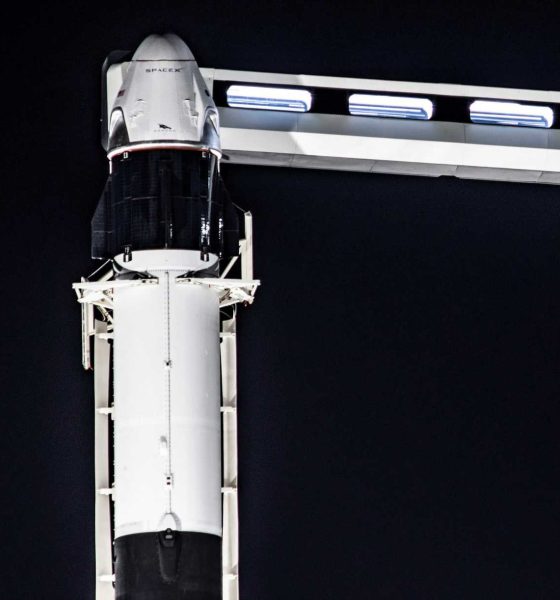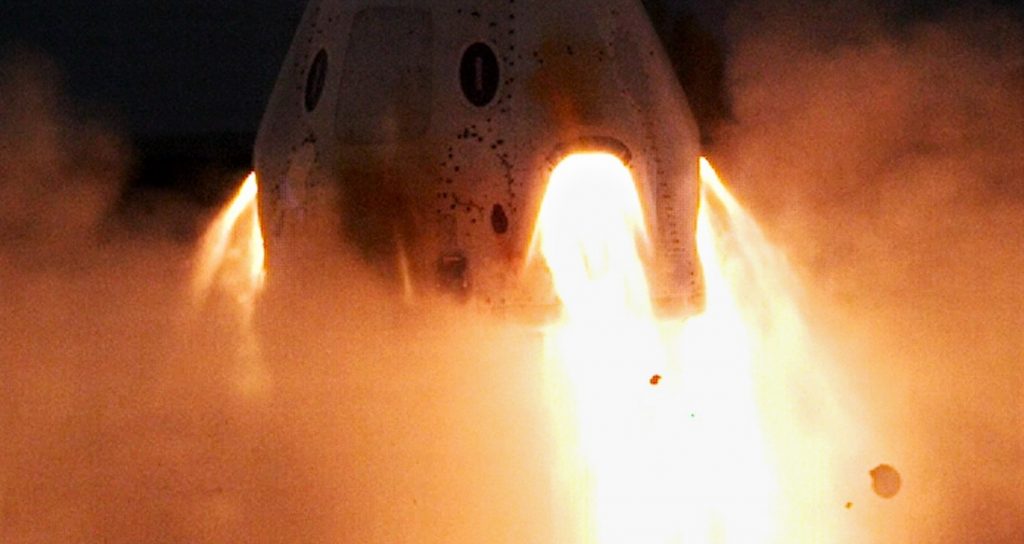

News
NASA says SpaceX's Crew Dragon abort test is go for launch on doomed Falcon 9 rocket
NASA has formally given SpaceX permission for Crew Dragon’s second launch – a crucial test flight that should be the last before SpaceX launches NASA astronauts to the International Space Station (ISS) for the first time ever.
Known as its In-Flight Abort (IFA) test, Crew Dragon will attempt to escape a Falcon 9 rocket while airborne, a feat that CEO Elon Musk says will almost certainly destroy the rocket in the process. Technically speaking, NASA and SpaceX completed what is known as a Launch Readiness Review (LRR) sometime on Thursday, allowing SpaceX to proceed with launch preparations. By all accounts, Crew Dragon’s IFA test will likely be one of the most spectacular SpaceX launches ever, given that it is all but guaranteed to result in the intentional in-flight failure of a massive Falcon 9 rocket – “destroyed in Dragon fire” according to Musk.
Thanks to a much smoother launch flow compared to Crew Dragon’s Demo-1 orbital launch debut on Falcon 9, SpaceX’s newest Crew Dragon capsule is scheduled to lift off from Kennedy Space Center Launch Complex 39A (KSC LC-39A) as early as 8 am EST (13:00 UTC), Saturday, January 18th. The In-Flight Abort test will likely be one of Crew Dragon’s most challenging hurdles yet but success would be a major boon for the spacecraft’s demonstrated safety. While both Boeing and SpaceX will ultimately ferry NASA astronauts to and from the ISS, only SpaceX chose to prove Crew Dragon’s in-flight abort capabilities in the real world.
Effectively condemned to destruction to support a greater cause after a productive life, Falcon 9 Block 5 booster B1046 rolled out to Pad 39A – Crew Dragon mounted atop it – on January 16th after successfully performing its last routine static fire on the 11th. As previously discussed on Teslarati, B1046 is the first Falcon 9 Block 5 booster completed by SpaceX and is thus also the oldest flightworthy rocket in the company’s substantial fleet.
“After becoming the first SpaceX booster to launch three times in December 2018, B1046 spent several months at SpaceX’s Hawthorne, CA factory undergoing inspections and refurbishment. At some point, SpaceX assigned the thrice-flown booster to support Crew Dragon’s In-Flight Abort (IFA) test – effectively a death sentence – and shipped the booster to Florida, where it publicly appeared for the first time in months on October 3rd, 2019. Given that four more Falcon 9 boosters have now successfully performed three (or even four) orbital-class launches each, B1046’s now-imminent demise is certainly disappointing but remains extremely pragmatic.”
Teslarati.com — January 15th, 2020
As such, there is arguably no better booster for SpaceX to expend even if its loss is still less satisfying than a successful post-launch landing. In fact, aside from NASA’s prematurely-retired Space Shuttle, the entire history of orbital-class rocketry has effectively operated on the assumption that it’s both normal and necessary for rockets to be almost entirely expendable.
Only by sheer force of will has SpaceX turned that assumption on its head, making the act of expending Falcon 9 or Falcon Heavy boosters feel suddenly morose. Even then, the practice of propulsively landing orbital-class boosters is scarcely four years old, while reusing those boosters has been ongoing for less than three years. As such, B1046’s demise should be enjoyed for what it ultimately is: the spectacular retirement of a rocket that has already helped launch three separate payloads to orbit.
Perhaps even more importantly, B1046’s sacrifice should – if things go as planned – also pave the way for Crew Dragon to launch its first NASA astronauts into orbit just a few months from now. For the test to be successful, however, Crew Dragon will have to perform an extremely precise string of maneuvers – the failure of any one of which could potentially lead to the spacecraft’s destruction.
“Traveling as fast as Mach 2.5 (860 m/s) at an altitude of 28 kilometers (17 mi), Crew Dragon will ignite its abort thrusters and attempt to escape, the very act of which will likely hammer the spacecraft’s windward surfaces with an extra dozen or so metric tons (~25,000 lb) of aerodynamic pressure. Crew Dragon C205 could thus find itself traveling almost Mach 3 (more than a kilometer per second) moments after separating from Falcon 9, eventually reaching an apogee of almost 75 km (45 mi), after which it will reenter the bulk of Earth’s atmosphere and have to deploy an array of parachutes to ensure a gentle Atlantic Ocean splashdown.”
Teslarati.com — January 13th, 2020

Unfortunately, Crew Dragon escaping a supersonic Falcon 9 also means that that same Falcon 9 – basically a thin, flexible tube designed to be as light as possible – will meet a supersonic blast of air the moment Dragon’s SuperDraco abort thrusters ignite. A bit like if a hurricane on all kinds of meteorological steroids just sort of punched a soda can for fun, that airstream will almost certainly obliterate Falcon 9’s sacrificial upper stage into a sort of aluminum snow, quickly revealing – and likely then destroying – B1046’s carbon fiber interstage.
The rest of the thrice-flown Falcon 9 booster is also liable to break up after that supersonic punch. In fact, SpaceX engineers are so confident in B1046’s imminent demise that the booster will have neither landing legs or grid fins come launch. In a best-case scenario, if, against all odds, B1046 survives Dragon’s escape, the intact booster will subsequently impact the Atlantic Ocean at terminal velocity and become a nice, artificial reef off the coast of Florida. Stay tuned for updates from Teslarati and photographers Jamie Groh and Richard Angle as Falcon 9 B1046’s demise inches ever closer.
Check out Teslarati’s Marketplace! We offer Tesla accessories, including for the Tesla Cybertruck and Tesla Model 3.

News
Tesla Model 3 becomes Netherlands’ best-selling used EV in 2025
More than one in ten second-hand electric cars sold in the country last year was a Tesla Model 3.

The Tesla Model 3 became the most popular used electric car in the Netherlands in 2025, cementing its dominance well beyond the country’s new-car market.
After years at the top of Dutch EV sales charts, the Model 3 now leads the country’s second-hand EV market by a wide margin, as record used-car purchases pushed electric vehicles further into the mainstream.
Model 3 takes a commanding lead
The Netherlands recorded more than 2.1 million used car sales last year, the highest level on record. Of those, roughly 4.8%, or about 102,000 vehicles, were electric. Within that growing segment, the Tesla Model 3 stood far ahead of its competitors.
In 2025 alone, 11,338 used Model 3s changed hands, giving the car an 11.1% share of the country’s entire used EV market. That means more than one in ten second-hand electric cars sold in the country last year was a Tesla Model 3, Auto Week Netherlands reported. The scale of its lead is striking: the gap between the Model 3 and the second-place finisher, the Volkswagen ID3, is more than 6,700 vehicles.
Rivals trail as residual values shape rankings
The Volkswagen ID.3 ranked a distant second, with 4,595 used units sold and a 4.5% market share. Close behind was the Audi e-tron, which placed third with 4,236 registrations. As noted by Auto Week Netherlands, relatively low residual values likely boosted the e-tron’s appeal in the used market, despite its higher original price.
Other strong performers included the Kia Niro, the Tesla Model Y, and the Hyundai Kona, highlighting continued demand for compact and midsize electric vehicles with proven range and reliability. No other model, however, came close to matching the Model 3’s scale or market presence.
News
Tesla Model Y Standard Long Range RWD launches in Europe
The update was announced by Tesla Europe & Middle East in a post on its official social media account on X.

Tesla has expanded the Model Y lineup in Europe with the introduction of the Standard Long Range RWD variant, which offers an impressive 657 km of WLTP range.
The update was announced by Tesla Europe & Middle East in a post on its official social media account on X.
Model Y Standard Long Range RWD Details
Tesla Europe & Middle East highlighted some of the Model Y Standard Long Range RWD’s most notable specs, from its 657 km of WLTP range to its 2,118 liters of cargo volume. More importantly, Tesla also noted that the newly released variant only consumes 12.7 kWh per 100 km, making it the most efficient Model Y to date.
The Model Y Standard provides a lower entry point for consumers who wish to enter the Tesla ecosystem at the lowest possible price. While the Model 3 Standard is still more affordable, some consumers might prefer the Model Y Standard due to its larger size and crossover form factor. The fact that the Model Y Standard is equipped with Tesla’s AI4 computer also makes it ready for FSD’s eventual rollout to the region.
Top Gear’s Model Y Standard review
Top Gear‘s recent review of the Tesla Model Y Standard highlighted some of the vehicle’s most notable features, such as its impressive real-world range, stellar infotainment system, and spacious interior. As per the publication, the Model Y Standard still retains a lot of what makes Tesla’s vehicles well-rounded, even if it’s been equipped with a simplified interior.
Top Gear compared the Model Y Standard to its rivals in the same segment. “The introduction of the Standard trim brings the Model Y in line with the entry price of most of its closest competition. In fact, it’s actually cheaper than a Peugeot e-3008 and costs £5k less than an entry-level Audi Q4 e-tron. It also makes the Ford Mustang Mach-E look a little short with its higher entry price and worse range,” the publication wrote.
Elon Musk
Elon Musk’s xAI bets $20B on Mississippi with 2GW AI data center project
The project is expected to create hundreds of permanent jobs, dramatically expand xAI’s computing capacity, and further cement the Mid-South as a growing hub for AI infrastructure.

Elon Musk’s xAI plans to pour more than $20 billion into a massive new data center campus in Southaven, Mississippi, marking the largest single economic development project in the state’s history.
The project is expected to create hundreds of permanent jobs, dramatically expand xAI’s computing capacity, and further cement the Mid-South as a growing hub for AI infrastructure.
xAI goes MACROHARDRR in Mississippi
xAI has acquired and is retrofitting an existing facility in Southaven to serve as a new data center, which will be known as “MACROHARDRR.” The site sits near a recently acquired power plant and close to one of xAI’s existing data centers in Tennessee, creating a regional cluster designed to support large-scale AI training and inference.
Once completed, the Southaven facility is expected to push the company’s total computing capacity to nearly 2 GW, placing it among the most powerful AI compute installations globally. The data center is scheduled to begin operations in February 2026.
Gov. Tate Reeves shared his optimism about the project in a press release. “This record-shattering $20 billion investment is an amazing start to what is sure to be another incredible year for economic development in Mississippi. Today, Elon Musk is bringing xAI to DeSoto County, a project that will transform the region and bring amazing opportunities to its residents for generations. This is the largest economic development project in Mississippi’s history,” he said.
xAI’s broader AI ambitions
To secure the investment, the Mississippi Development Authority approved xAI for its Data Center Incentive program, which provides sales and use tax exemptions on eligible computing hardware and software. The City of Southaven and DeSoto County are also supporting the project through fee-in-lieu agreements aimed at accelerating development timelines and reducing upfront costs.
Founded in 2023 by Elon Musk, xAI develops advanced artificial intelligence systems focused on large-scale reasoning and generative applications. Its flagship product, Grok, is integrated with the social media platform X, alongside a growing suite of APIs for image generation, voice, and autonomous agents, including offerings tailored for government use.
Elon Musk highlighted xAi’s growth and momentum in a comment about the matter. “xAI is scaling at an immeasurable pace — we are building our third massive data center in the greater Memphis area. MACROHARDRR pushes our Colossus training compute to ~2GW – by far the most powerful AI system on Earth. This is insane execution speed by xAI and the state of Mississippi. We are grateful to Governor Reeves for his support of building xAI at warp speed,” Musk said.








